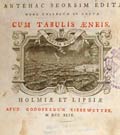Cabinet 11 - Philosophia Botanica
 The Uppsala University Botanical Garden was founded in 1655 and is the oldest botanical garden in Sweden. In 1728 Linnaeus was a medical student at Uppsala University, where he utilized facilities at the garden. However, it was as Professor of Medicine in 1741, that he had greater impact on the garden, which at the time was run-down and neglected. He took charge and totally reconstructed it, adding new divisions, and with help from friends all over Europe, expanded its seed resources. Convinced of the economic value of tea, he successfully grew a tea plant in 1762, which finally flowered in 1765. Today the Botanical Garden extends over 34 acres and is now called Linnaeus's Garden. The two maps on display are from Amoenitates Academicae [Academic Delights], a work that contains some of the 186 dissertations published while Linnaeus was President of the Faculty of Medicine.
The Uppsala University Botanical Garden was founded in 1655 and is the oldest botanical garden in Sweden. In 1728 Linnaeus was a medical student at Uppsala University, where he utilized facilities at the garden. However, it was as Professor of Medicine in 1741, that he had greater impact on the garden, which at the time was run-down and neglected. He took charge and totally reconstructed it, adding new divisions, and with help from friends all over Europe, expanded its seed resources. Convinced of the economic value of tea, he successfully grew a tea plant in 1762, which finally flowered in 1765. Today the Botanical Garden extends over 34 acres and is now called Linnaeus's Garden. The two maps on display are from Amoenitates Academicae [Academic Delights], a work that contains some of the 186 dissertations published while Linnaeus was President of the Faculty of Medicine.
Caroli Linnaei, Amoenitates Academicae [Academic Delights]. Holmiae [Stockholm] et Lipsiae [Leipzig], 1749. DeB Gb 1749 L
 'The true botanist arranges his plants systematically; and he does not enumerate them out of order.' So wrote Linnaeus about the character of the botanist, whom he classified into true authors or learned compilers. Linnaeus's Philosophia Botanica is a compilation of his lectures on botany and was first published in Stockholm in 1751. Linnaeus was flamboyant, boastful, and unorthodox, yet his lectures – delivered with passion and enthusiasm – captured the imagination of his listeners. He gained many disciples, or as he called them: 'Apostles'. Philosophia Botanica also advanced his ideas and development of his binominal nomenclature applied to plants. This is the first full English translation.
'The true botanist arranges his plants systematically; and he does not enumerate them out of order.' So wrote Linnaeus about the character of the botanist, whom he classified into true authors or learned compilers. Linnaeus's Philosophia Botanica is a compilation of his lectures on botany and was first published in Stockholm in 1751. Linnaeus was flamboyant, boastful, and unorthodox, yet his lectures – delivered with passion and enthusiasm – captured the imagination of his listeners. He gained many disciples, or as he called them: 'Apostles'. Philosophia Botanica also advanced his ideas and development of his binominal nomenclature applied to plants. This is the first full English translation.
